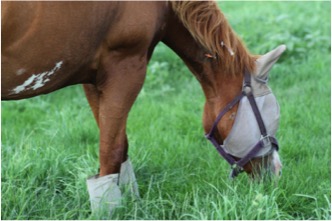grazing
-
The prolonged cold weather during the Christmas holiday has a lot of producers asking, “Are my winter annuals going to regrow?” Unfortunately, there isn’t a clear answer that we can offer to this question. Many cool season forages can handle subfreezing temps for short periods and the degree of damage depends on air temperature, soil…
Posted in: Uncategorized -

As a horse owner & County Extension Agent, I hope that you will find value in my mixture of “by the book recommendations” and personal experience. One thing I would like to encourage horse owners and trainers to do is engage with their local Extension Agent. Pasture management, it seems, has a different meaning for…
-

The fact that rotational grazing systems are a more efficient use of forages than continuous grazing should not be a novel idea. Years of research have proven that giving forages ample time to rest and recuperate between grazing times, produces more, higher quality yield. Installing a rotational grazing system is not quite as easy as…
-

Are you looking to improve your grazing management system? The first step is to develop a grazing management plan! To better manage your grazing, you have to have goals. Our ultimate goals are to improve our efficiency, reduce pasture waste, conserve surplus forage, improve animal performance, and improve forage quality at its time of use.…
-

While bermudagrass and bahiagrass are great warm season perennials, warm season annual grasses work well in a forage system to offer high quality forage throughout the summer months. There are several warm season annuals on the market with sorghum x sudangrass and pearl millet being the most popular. In this article we will discuss grazing…
-
A survey reported online recently by ‘Progressive Cattle’ asked cattlemen what aspect of their management they would most like to improve. By a wide margin, “Grazing” was identified as the item that benefit from an upgrade. Many producers recognize intuitively how influential grazing management can be on the success of a livestock operation. Perhaps unfortunately, no…
-
It is a generally accepted fact that mineral supplementation is an important part of ruminant nutrition. Proper mineral and vitamin nutrition contribute to strong immune systems, reproductive performance, and weight gain. A properly balanced mineral program requires consideration of animal nutritional needs, forage/feed intake and its mineral concentration, and mineral supplement intake and its concentration.…
-

As agriculturalists, our main goal is to produce the best and most productive crop for the least amount of money. As a cattle producer, we often make decisions about our herd by selecting genetics from a wide variety of traits including weaning weights, birth weights, milk production, average daily gain, and more. These traits are…
-

If you do a Google search for Sericea Lespedeza (Lespedeza cuneata), you will see results ranging from articles about controlling it as a weed, touting it as a highly invasive forb that creates a tremendous seed bank; to articles that praise its ability to help fight internal parasites in small ruminants. Determination of whether it…
-

By Savannah Tanner Emanuel County CEA With over 80,000 head of horses in the state of Georgia, horse owners are looking for efficient and nutritional forage options to feed to their animals. A good rule of thumb for horse owners is that your horse should consume at least one percent of its body weight in hay or pasture daily. For a 1,200…